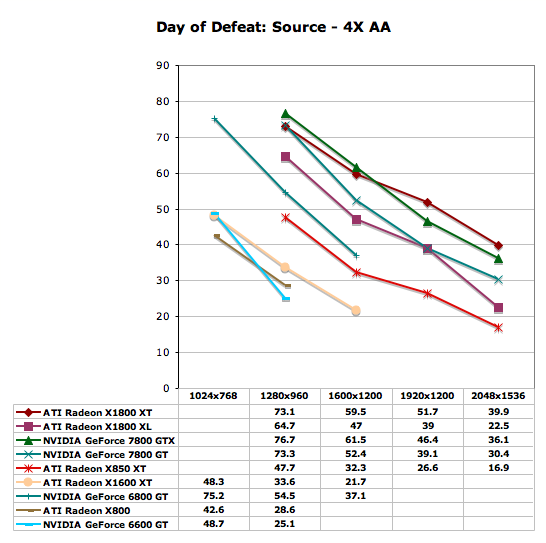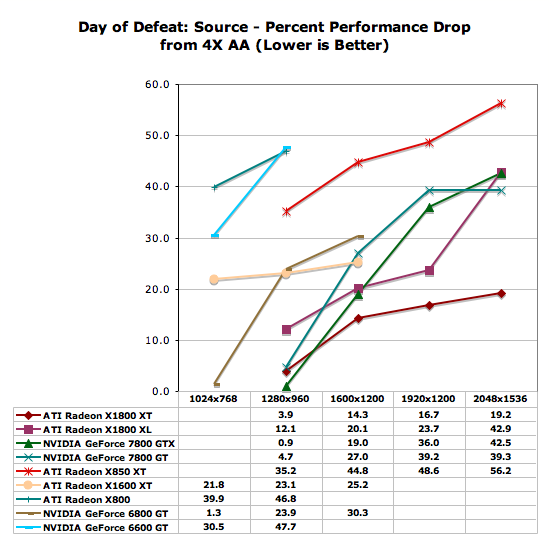ATI's X1000 Series: Extended Performance Testing
by Derek Wilson on October 7, 2005 10:15 AM EST- Posted in
- GPUs
Day of Defeat: Source Performance
Rather than test Half-Life 2 once again, we decided to use a game that pushed the engine further. The reworked Day of Defeat: Source takes 4 levels from the original game and adds not only the same brush up given to Counter Strike: Source, but HDR capabilities as well. The new Source engine supports games with and without HDR. The ability to use HDR is dependent on whether or not the art assets needed to do the job are available.
In order to push this test to the max, the highest settings possible were tested. This includes enabling the reflect all and full HDR options. Our first test was run with no antialiasing and trilinear filtering, and our second set of numbers was generated after 4x antialiasing and 8x anisotropic filtering were enabled.
From the looks of our graph, we hit a pretty hard CPU barrier near 80 frames per second. The 7800 GTX sticks the closest to this limit for the longest, but still can't help but fall off when pushing two to three megapixel resolutions. The 7800 GT manages to out-perform the X1800 XT, but more interestingly, the X850 XT and X1800 XL put up nearly identical numbers in this test. The X1300 Pro and the X1600 XT parallel each other as well, with the X1600 XT giving almost the same numbers as the X1300 Pro one resolution higher. The 6600 GT (and thus the 6800 GT as well) out-performs the X1600 XT pretty well.

Antialiasing changes the performance trends a bit, but at lower resolutions, we still see our higher end parts reaching up towards that 80 fps CPU limit. The biggest difference that we see here is that the X1000 series are able to gain the lead in some cases as resolution increases with AA enabled. The X1800 XT takes the lead from the 7800 GTX at 1920x1200 and at 2048x1536. The 7800 GT manages to hold its lead over the X1800 XL, but neither is playable at the highest resolution with 4xAA/8xAF enabled. The 6600 GT and X1600 XT manage to stop being playable at anything over 1024x768 with AA enabled. On those parts, gamers are better off just increasing the resolution to 1280x960 with no AA.

The 7800 series parts try to pretend that they scale as well as the X1800 series at 1600x1200 and below when enabling AA. The X850 XT scales worse than the rest of the high end, but this time, the X1600 XT is able to show that it handles the move to AA better than either of the X8xx parts test and better than the 6600 GT as well. The 6800 GT takes the hit from antialiasing better than the X1600 XT though.

Doom 3 showed NVIDIA hardware leading at every step of the way in our previous tests. Does anything change when looking at numbers with and without AA enabled?
Rather than test Half-Life 2 once again, we decided to use a game that pushed the engine further. The reworked Day of Defeat: Source takes 4 levels from the original game and adds not only the same brush up given to Counter Strike: Source, but HDR capabilities as well. The new Source engine supports games with and without HDR. The ability to use HDR is dependent on whether or not the art assets needed to do the job are available.
In order to push this test to the max, the highest settings possible were tested. This includes enabling the reflect all and full HDR options. Our first test was run with no antialiasing and trilinear filtering, and our second set of numbers was generated after 4x antialiasing and 8x anisotropic filtering were enabled.
From the looks of our graph, we hit a pretty hard CPU barrier near 80 frames per second. The 7800 GTX sticks the closest to this limit for the longest, but still can't help but fall off when pushing two to three megapixel resolutions. The 7800 GT manages to out-perform the X1800 XT, but more interestingly, the X850 XT and X1800 XL put up nearly identical numbers in this test. The X1300 Pro and the X1600 XT parallel each other as well, with the X1600 XT giving almost the same numbers as the X1300 Pro one resolution higher. The 6600 GT (and thus the 6800 GT as well) out-performs the X1600 XT pretty well.

Antialiasing changes the performance trends a bit, but at lower resolutions, we still see our higher end parts reaching up towards that 80 fps CPU limit. The biggest difference that we see here is that the X1000 series are able to gain the lead in some cases as resolution increases with AA enabled. The X1800 XT takes the lead from the 7800 GTX at 1920x1200 and at 2048x1536. The 7800 GT manages to hold its lead over the X1800 XL, but neither is playable at the highest resolution with 4xAA/8xAF enabled. The 6600 GT and X1600 XT manage to stop being playable at anything over 1024x768 with AA enabled. On those parts, gamers are better off just increasing the resolution to 1280x960 with no AA.

The 7800 series parts try to pretend that they scale as well as the X1800 series at 1600x1200 and below when enabling AA. The X850 XT scales worse than the rest of the high end, but this time, the X1600 XT is able to show that it handles the move to AA better than either of the X8xx parts test and better than the 6600 GT as well. The 6800 GT takes the hit from antialiasing better than the X1600 XT though.

Doom 3 showed NVIDIA hardware leading at every step of the way in our previous tests. Does anything change when looking at numbers with and without AA enabled?










93 Comments
View All Comments
tfranzese - Friday, October 7, 2005 - link
These points were brought up about the first article too. It's a big improvement, I agree, but it's still not to the level that this site was founded on.DerekWilson - Friday, October 7, 2005 - link
We already commented on the FEAR Demo -- we won't test a game that doesn't show shipping performance characteristics. We are working on getting our hands on a prerelease copy of the shipping game for testing.We have had black and white 2 in house since it became available at best buy (as today is the official US launch, we got it a couple days early). We just haven't had enough time to finalize tests for it.
We will look into the recently released call of duty 2 demo among others. I agree that we could have done things better, and hopefully our coming follow up will hit all the points people want covered.
If you have any other suggestions, please let us know -- we will try our best to include them.
PrinceGaz - Friday, October 7, 2005 - link
As for other suggestions, how about some games other than FPS or FPS-view (EQ2) style games? A driving game like NFS:U2 or colin McRae Rally 2005 would be an excellent addition. Then you should have some sort of flight/space-sim, like maybe X2. And a roleplaying game that isn't viewed from a first-person perspective. By including games that have a totally different style of graphics, you'll get a better idea of how well the card performs. X2 for instance would require totally different graphics performance than Half-Life 2.I know some of the games I've mentioned don't have a benchmarking mode, but use FRAPS to get the average framerate. And the minimum framerate. In fact the minimum framerate is more important than the average so you should include it as a matter of course in *all* tests, even to the point of dropping the average framerate if you don't have space. No one is too bothered if the average framerate while playing is 45 or 50fps while playing a game, but the difference between minimum framerates of 20 and 25fps would definitely be noticeable. I'm sure others will agree.
This (and many other) site seems to think FPS games are all people play, but a lot of us play games from all genres, so including them would be useful.
coldpower27 - Saturday, October 8, 2005 - link
I support the use of X2: The Threat as a benchmark, I also support the use of shipping games to compare numbers, so Anandtech should benchmark Black & White 2 as it is now available, plus Call of Duty 2 & Fear when they become available.bob661 - Friday, October 7, 2005 - link
Even though I found the original article very informative (I guess I can read well), this one was much better. The bar graphs don't show how the performance goes down as you raise the resolution and turn on the eye candy.zmanww - Friday, October 7, 2005 - link
what no Overclocking?come on I want to see that this baby can really do.
Peldor - Friday, October 7, 2005 - link
I don't think the usual overclocking utilities are working for the X1x00 cards yet.DerekWilson - Friday, October 7, 2005 - link
this is true -- we wanted to test slower versions and couldn't because of this.also reference board overclocking isn't always the best indication of retail board performance.
Lonyo - Friday, October 7, 2005 - link
Would be nice to see some analysis of ATi's SM3 implimentation, with SM2 vs SM3 benchmarks in the games which do support SM2 and SM3 paths.tfranzese - Friday, October 7, 2005 - link
From the article:I think the analysis and the conclusions up to this point have been far short sighted. Seems that the games that are using SM3.0 are taking considerable advantage of the new architecture. The Tech Report, Hexus and others were able to show that much.